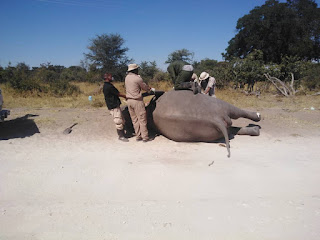By Boniface Keakabetse
The death of 450 elephants in Botswana’s Okavango Delta in 2020 have ignited calls for an urgent creation of a wildlife diseases surveillance programme to avoid similar future devastation.
The alarming discovery of hundreds of elephant carcasses spotted strewn along water pools between March- June 2020 after dying from what was at the time a mysterious disease, is classified as one of worst elephants die-off in Botswana.
Causes of these deaths had remained unexplained for almost two months. In September 2020 the Department of Wildlife and National Parks (DWNP announced they identified the cause to be cyanobacteria neurotoxins.
Cyanobacteria are poisons that are released by algae that commonly bloom in stagnant, nutrient –rich waters in wider southern Africa including Botswana. Cyanobacteria neurotoxins affect the animals’ nervous systems when ingested.
Two years later, Dr. Kabelo Senyatso, Director of Department of Wildlife and National Parks told The Okavango Express: ‘’our position is still the same. The cause of the mortalities was cyanobacteria. We are continuing to observe and monitor the situation in the Okavango panhandle in collaboration with Okavango Research Institute and Department of Veterinary Services. ‘’
However, some experts are still not convinced that cyanobacteria was the cause. They feel that the 2020 mortality disease investigation was delayed and that the testing process was not conclusive.
Dr. Frederick Verreynne who is a Veterinary Surgeon at Vet and Agric Consultants told The Okavango Express that he cannot exclude other infectious or toxic agents as the cause of the mortalities. “If it was not Cyanobacteria, it obviously had to be something else. But we did not manage to get enough good quality samples of fresh (recently died) carcasses at the time to determine the other possibilities.”
According to Dr. Verreynne Cyanobacteria needs favorable conditions to thrive whose presence in the area of deaths was in doubt in the months from March to May when the deaths happened.
Dr. Verreynne added: ‘’For these blooms to occur, water temperatures need to be above 20 degrees Celsius , it must be calm, shallow and clear with enough sunlight to reach the deeper layers, and produce high levels of nitrogen and phosphate for nutrients to bloom. Therefore calm shallow eutrophic waters (with aquatic plants that can deplete the oxygen levels, and increase CO2 and phosphates) usually create the ideal conditions for algae blooms.’’
He explained: ‘It is possible that some waterholes in the mortalities area could create ideal conditions for the bloom for short periods, but considering that the die-offs started already in March while it was still raining and waterholes were not stagnant, most waterholes had very murky water most of the time that lacked vegetation that can provide the eutrophic conditions for Cyanobacteria to thrive.’’
Dr. Verreynne stated that Botswana is long overdue to devise a structured wildlife disease surveillance programme that can recognise and diagnosed the presence of disease pathogens and reservoirs to prevent disastrous outbreaks.
He added that a wildlife disease surveillance programme will aid the recognition of outbreaks in time and guide timely commencement of investigations sooner rather than later.
Further, according to Dr. Verreynne, disease investigations need a multidisciplinary approach involving a wider expertise from both the private sector and government.
He posited that during investigations all hypothesis and possible disease differential diagnosis needs to be verified on the ground rather than relying simply on remote sensing techniques or lab based diagnosis.
Dr. Verreynne stated: ‘’Fast response and thorough investigations with proper sample collection techniques and preservation is often the difference between certain and uncertain diagnosis. Coordinated cooperation and collaboration between private, government, local and international institutions are important. The most important lesson may still come. With the right conditions the disease will return. This time it may kill 4000 and not 400. I believe we missed an opportunity.’’
Keodumetse Morotsi, Chairman of Makgobokgobo Youth Trust called for intensive community education in all the villages in proximity of where the mortalities happened. He said: ‘’ as the communities living where the mortalities happened we need to be informed about that cyanobacteria disease that killed the elephants. Government officials were in our area during the mortalities to address the communities. But, they did not return to tell us about the cause of the mortalities. We just heard about it in the media. Our fear is that animal diseases could spread to people. So, to avoid future fatalities it is important that the community is provided with requisite information. Who knows? The disease may return.’’
Dr. Nilingisi Babayani of the Okavango Research Institute (ORI) admitted that there is a collaboration between ORI and DWNP for monitoring purposes. “Our relationship with DWNP is old. During the elephants die-off we collected samples’’
Dr Babayani explained: “ORI is currently involved in a project to investigate elephant mortality in the Okavango Delta in collaboration with other stakeholders. Results from the multidisciplinary review of the evidence gathered from sudden death investigations would create a database to support plans for future monitoring.
He alluded that from this monitoring exercise, tools could be developed for dynamic multidisciplinary evaluation, focused field sampling, standard operating procedures, pathology training, community engagement, information chain, mortality thresholds to trigger specific further investigations.
‘’This would build local capacity to service future monitoring and investigation in the country, along with specific remote staff and community training. The current die-off could therefore be used to develop and trial tools and teams for subsequent application to ongoing one Health monitoring in the Okavango Delta for elephants and potentially other wildlife species..’’ he said.
Dr Babayani revealed that the die-off areas have high and growing elephant densities and growing human and livestock populations, amplifying risks of environmental degradation, disease emergence and cross-transmission, which bring risks to one Health under environmental change.

